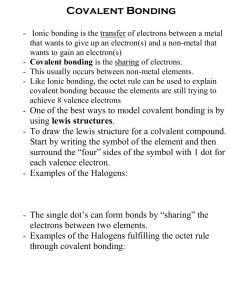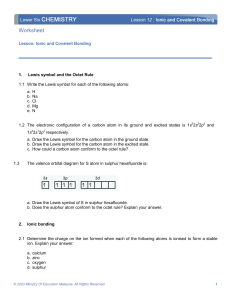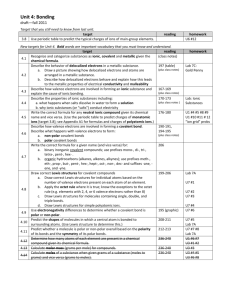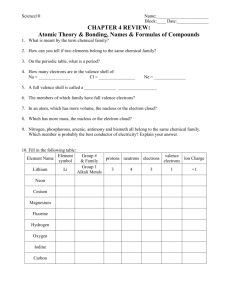Covalent bonding webquest
advertisement
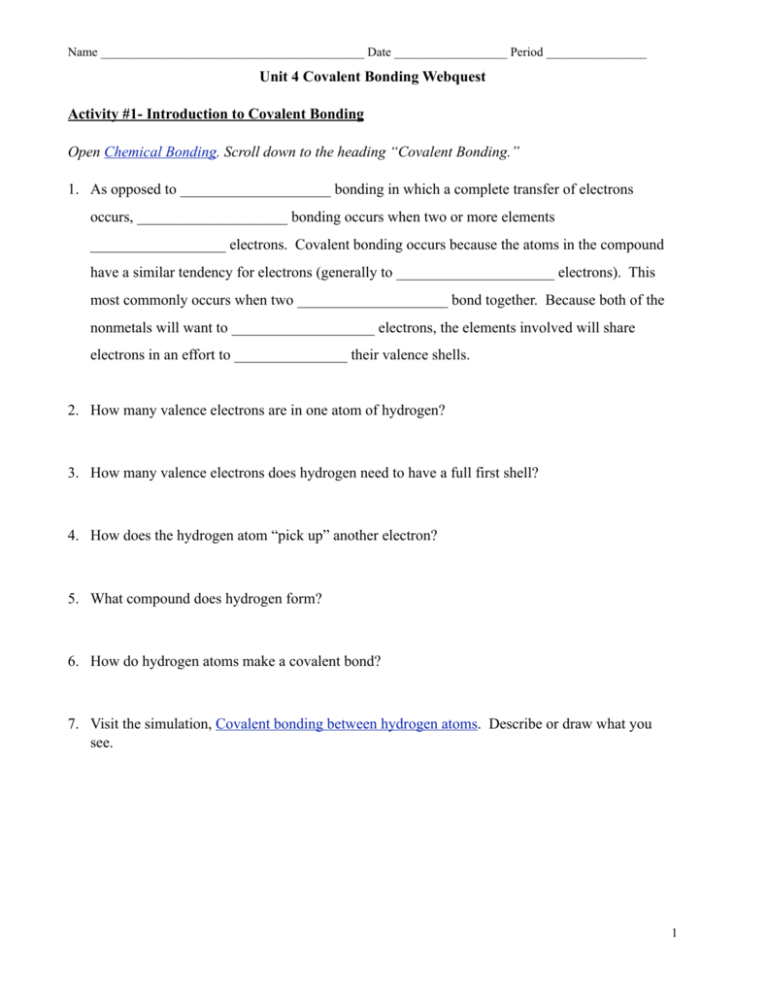
Name __________________________________________ Date __________________ Period ________________ Unit 4 Covalent Bonding Webquest Activity #1- Introduction to Covalent Bonding Open Chemical Bonding. Scroll down to the heading “Covalent Bonding.” 1. As opposed to ____________________ bonding in which a complete transfer of electrons occurs, ____________________ bonding occurs when two or more elements __________________ electrons. Covalent bonding occurs because the atoms in the compound have a similar tendency for electrons (generally to _____________________ electrons). This most commonly occurs when two ____________________ bond together. Because both of the nonmetals will want to ___________________ electrons, the elements involved will share electrons in an effort to _______________ their valence shells. 2. How many valence electrons are in one atom of hydrogen? 3. How many valence electrons does hydrogen need to have a full first shell? 4. How does the hydrogen atom “pick up” another electron? 5. What compound does hydrogen form? 6. How do hydrogen atoms make a covalent bond? 7. Visit the simulation, Covalent bonding between hydrogen atoms. Describe or draw what you see. 1 Name __________________________________________ Date __________________ Period ________________ 8. Label the substances below as “ionic” or “covalent”. ____________________ ______________________ Activity #2- Introduction to Lewis Structures 1. Go to Lewis Structures ( electron dot diagrams). Fill in the chart. 2. Write the Lewis structure for an atom of each of the following elements. NOTE: You must look up the group # on the periodic table to do this. Check your answers here. Element Lewis structure Element Lewis structure Element Lewis structure Element Barium Sulfur Silicon Arsenic Xenon Rubidium Indium Bromine Lewis structure 2 Name __________________________________________ Date __________________ Period ________________ Go to Covalent Bonding. H2 Watch it here! H2 See an explanation 3. Draw the Lewis structure for a 4. Once the H atoms bond, how many electrons a. H atom a. does each atom have? _______ b. are shared? _______ b. H2 molecule 5. Each atom is now stable like the noble gas ________________. HBr Watch it here! HBr See an explanation 6. Draw the Lewis structure for a 7. How many valence electrons are necessary for a full shell for a. H atom a. an H atom? ________ b. a Br atom? _________ b. Br atom 8. After bonding, how many electrons a. are shared by the H and Br? ______ c. HBr molecule b. does H have surrounding it? ______ c. does Br have surrounding it? ______ NH3 Watch it here! NH3 See an explanation 9. Draw the Lewis structure for a 10. How many valence electrons necessary for a full shell for a. H atom a. an H atom? _______ b. N atom c. NH3 molecule b. a N atom? _______ 11. After bonding, does each atom obey the octet rule? 3 Name __________________________________________ Date __________________ Period ________________ Activity #3- Lewis Structures for molecules (single bonds) Open Dr. Gutow’s Lewis Structure Tutorial. Follow the steps for each of the following compounds and fill in the diagrams and charts. CH4 Step 1: Atom CF2Cl2 Step 1: # Valence electrons Total CH4 Step 2: Picture so far Atom Total CF2Cl2 Step 2: Picture so far Total valence electrons Total valence electrons Used so far Used so far Remaining Remaining CH4 Step 3: Why are you done after step 2 for this molecule? # Valence electrons CF2Cl2 Step 3: Picture so far Total valence electrons Used so far Remaining CF2Cl2 Step 3: Why are you done after step 3 for this molecule? 4 Name __________________________________________ Date __________________ Period ________________ Open Molecular Geometry and Bonding and choose “LEWIS STRUCTURES HAVING ONLY SINGLE BONDS - Quiz” from the list. These quizzes are randomly generated so everyone will have different questions. Enter the molecular formula given (example: NH2O) and draw the correct Lewis Structure for each question. After you check your answers, you can hit the back button on your browser to see the Lewis Structures again. Question Molecular formula Lewis Structure 1 2 3 Activity #4- Lewis Structures for molecules (multiple bonds) Open Dr. Gutow’s Lewis Structure Tutorial. Follow the steps for each of the following compounds and fill in the diagrams and charts. SO2 Step 1: Atom Total SO2 Step 2: Picture so far O3 Step 1: # Valence electrons Atom # Valence electrons Total O3 Step 2: Picture so far 5 Name __________________________________________ Date __________________ Period ________________ Total valence electrons Total valence electrons Used so far Used so far Remaining Remaining SO2 Step 3: Picture so far O3 Step 3: Picture so far Total valence electrons Total valence electrons Used so far Used so far Remaining Remaining SO2 Step 4: Picture so far O3 Step 4: Picture so far Total valence electrons Total valence electrons Used so far Used so far Remaining Remaining SO2 Step 5: Picture so far O3 Step 5: Picture so far Total valence electrons Total valence electrons Used so far Used so far Remaining Remaining 6 Name __________________________________________ Date __________________ Period ________________ Open Molecular Geometry and Bonding and choose “LEWIS STRUCTURES HAVING DOUBLE BONDS - Quiz” from the list. These quizzes are randomly generated so everyone will have different questions. Enter the molecular formula and draw the correct Lewis Structure for each question. After you check your answers, you can hit the back button on your browser to see the Lewis Structures again. Question Molecular formula Lewis Structure 1 2 3 7 Name __________________________________________ Date __________________ Period ________________ Open Molecular Geometry and Bonding and choose “LEWIS STRUCTURES INVOLVING TRIPLE BONDS - quiz” from the list. These quizzes are randomly generated so everyone will have different questions. Enter the molecular formula and draw the correct Lewis structure for each question. After you check your answers, you can hit the back button on your browser to see the Lewis structures again. Question Molecular formula Lewis Structure 1 2 3 Activity #5 - Naming Covalent Compounds Open Naming Covalent Compounds Simple covalent compounds are generally named by using prefixes to indicate how many atoms of each element are shown in the formula. Also, the ending of the last (most negative) element is changed to -ide. 1. When is the mono- prefix not used to show one atom of an element? 1 2 3 2. When do you drop the “o” and “a” endings of these prefixes? 4 5 6 8 Name __________________________________________ Date __________________ Period ________________ 3. How do you know which element to put first in the name? 4. Name the following compounds. a. PH3 __________________________________________ b. CO __________________________________________ c. HI ___________________________________________ d. N2O3 _________________________________________ 5. Open Nomenclature. What are the common names of: a. H2O _________________________________________ b. NH3 _________________________________________ c. CH4 _________________________________________ 6. Write the formulas for the following covalent compounds. Check your answers here. a. antimony tribromide __________________________________ b. hexaboron monosilicide __________________________________ c. chlorine dioxide __________________________________ d. hydrogen iodide __________________________________ e. iodine pentafluoride __________________________________ f. dinitrogen trioxide __________________________________ g. ammonia __________________________________ h. phosphorus triiodide __________________________________ 9 Name __________________________________________ Date __________________ Period ________________ 7. Write the names for the following covalent compounds. Check your answers here. i. P4S5 __________________________________ j. O2 ___________________________________ k. SeF6 __________________________________ l. Si2Br6 _________________________________ m. SCl4 __________________________________ n. CH4 __________________________________ o. B2Si __________________________________ p. NF3 ___________________________________ Activity #6- Comparing Properties of Ionic and Covalent Substances Visit the website Bonding by Analogy: Dog - Bone Bonds, and write an explanation of each of the following types of bonding in terms of ATOMS AND ELECTRONS. You may also find the videos helpful. 1. Ionic bonds: 2. Covalent bonds: 3. Polar covalent bonds: 4. Metallic bonds: 10 Name __________________________________________ Date __________________ Period ________________ Open Review Ionic and Covalent Compounds. Fill in the charts. Definitions For the quiz questions below, write the definition in your notes, then check the first answer pull down box for the correct answer, and the second pull down box for the second half of the definition. .... in terms of electrons .... types of elements Covalent bonding: Covalent bonding: Polar covalent bonding: Polar covalent bonding: Non-polar covalent bonding: Non-polar covalent bonding: Ionic bonding: Ionic bonding: 11 Name __________________________________________ Date __________________ Period ________________ Compound Type and bonding Graphic Image For the quiz questions below, click on the graphic for the molecular structure, then write in the type of bonding (ionic, polar covalent, non-polar covalent), and then the electron definition. Finally, check the first answer pull down for the correct answer. Iodine I2 Hydrochloric acid HCl Oxygen O2 Magnesium Oxide MgO Water H2O Sodium Fluoride NaF Hydrogen H2 Methane CH4 Iron (III) oxide Fe2O3 Magnesium Nitride Mg3N2 Ethane C2H6 Carbon monoxide CO Carbon dioxide CO2 12 Name __________________________________________ Date __________________ Period ________________ Open Ionic & Molecular Compounds. Fill in the table. Table: Comparing ionic and molecular compounds. Molecular compounds Ionic compounds Smallest particles Origin of bonding Forces between particles Elements present Metallic elements present Electrical conductivity State at room temperature Melting and boiling points Other names 13 Name __________________________________________ Date __________________ Period ________________ Activity #7: Review Open Lewis Dot Structures (Multiple Choice). Read the directions and do 8 problems. Write the formula and correct Lewis Dot Structure in the table. Formula Lewis Dot Structure Open Classifying Compounds Quiz. These quizzes are randomly generated so you must write out the questions and answers. Feel free to summarize the question rather than writing it word-for-word. 1. 2. 3. 4. 5. 6. 14 Name __________________________________________ Date __________________ Period ________________ 15 Name __________________________________________ Date __________________ Period ________________ 16

